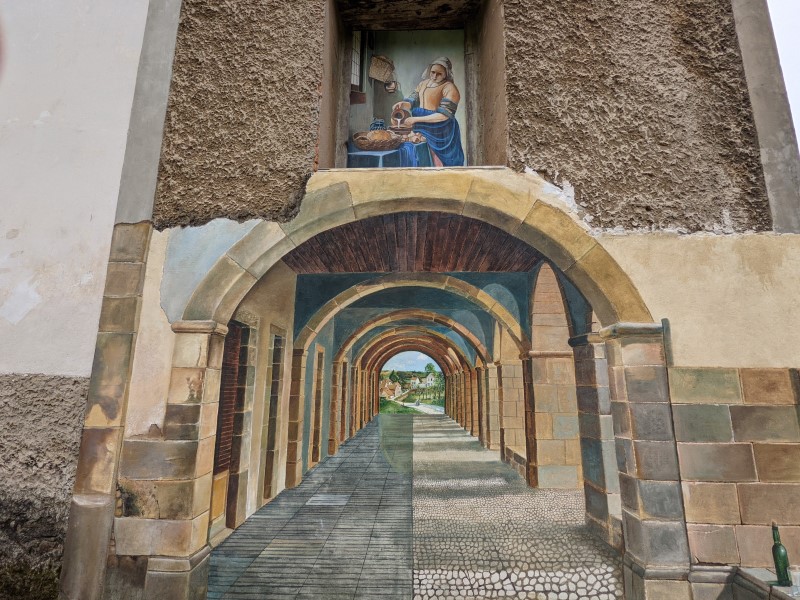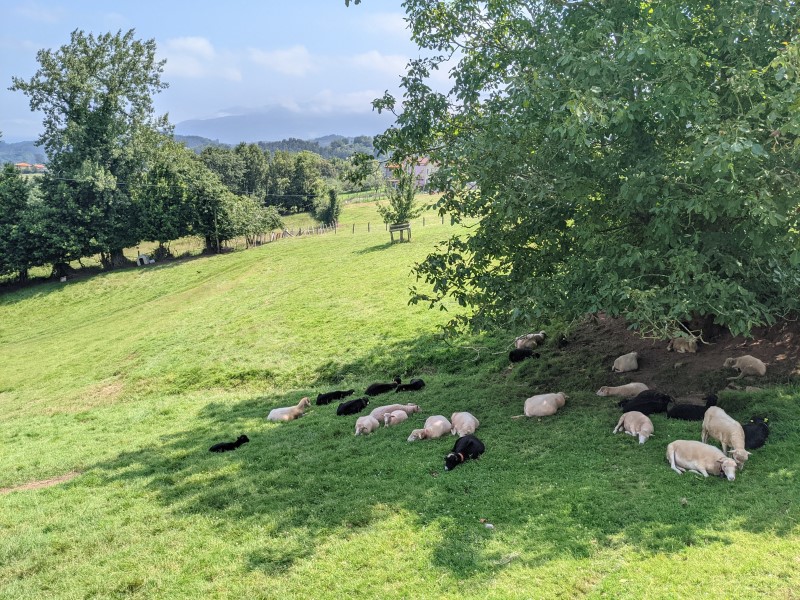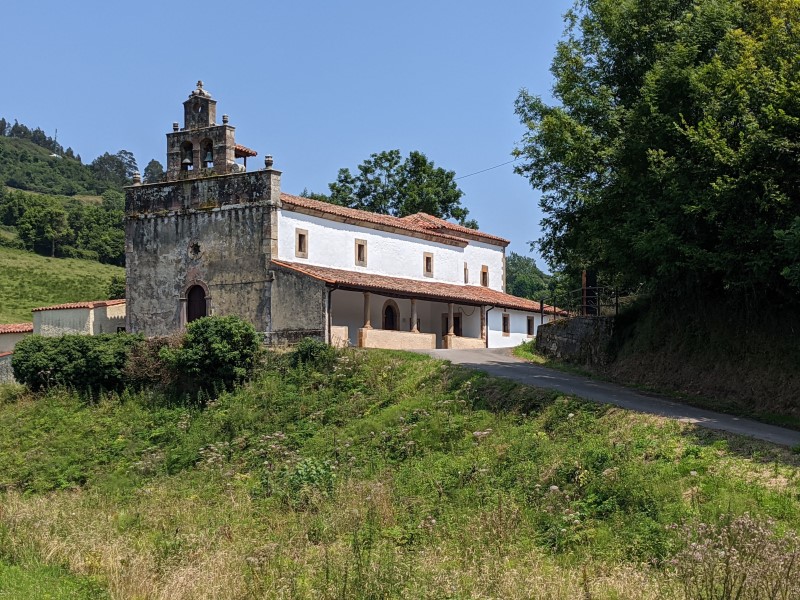
Basic Details
- Starting point: Iglesia Santa Maria Magdalena, Ribadesella.
- Ending point: Pilgrim albergue in a small village of Priesca.
- Availability of alternative routes: Not really, but there is a small coastal detour that you can follow from La Isla to Colunga. It passes along two interesting spots, something you won’t see elsewhere on Camino del Norte. First place, “Las trincheras de la Isla“, where you can see trenches from Spanish civil war (and perhaps give gratitude for not even having to sleep and live in such narrow ditches for days on end…). And it is a beautiful green location as well. And second one, “Las Huellas Fosiles de Dinosaurios“, the location at the edge of a beautiful beach of La Griega, where you can see the footprints of dinosaurs from the Jurassic era. Entrance is free of charge. This detour will add 1.5 kilometers to your walk, with about 150 extra vertical meters gained and lost. In my opinion though, on a good day and especially if you decide to end your day in Colonga (without continuing to Priesca), it is a detour worth making.
- Distance: 29 km (download GPS here).
- Elevation difference: +690m, – 550m
- Link to online map: Official camino route: here. Route with the small coastal detour near Colunga: here.
- Difficulty score: 4/5.
- Beauty score: 3/5.
- Terrain/asphalt: 25%/75% (too much asphalt walking again, but at least the roads you will follow today are not busy at all when it comes to traffic).
- Next stage: Camino del Norte, stage no. 17, Priesca – Gijon.
- Previous stage: Camino del Norte, stage no. 15, Llanes – Ribadesella.
Elevation profile for the route
 – Many small hills and descents today, which adds up to over 650 vertical meter gain. Definitely the trickiest part is from Colunga to Priesca, the last kilometers of the stage, so keep that on your mind and try to save some strengths for the last push to the albergue :).
– Many small hills and descents today, which adds up to over 650 vertical meter gain. Definitely the trickiest part is from Colunga to Priesca, the last kilometers of the stage, so keep that on your mind and try to save some strengths for the last push to the albergue :).
Advanced info about the stage
- Trail marking: Overall very good at this stage, and no need to worry of getting lost. The only point that can be a bit confusing is a marked detour to Prado, which is a small town with all services in the middle of the stage (but no pilgrim albergue though). The detour is well sign-posted though, and you should have no problems recognizing it (and avoiding it).
- Alternative route info: As mentioned in the previous section, you can make a short detour to the coast from La Isla to Colunga, to see the trenches from Spanish civil war, and the footprints of dinosaurs. The trail is called “Senda Costera Arenal“, and it splits from the Camino at the edge of La Isla. The split isn’t well marked, but basically turning right from the main road anywhere in La Isla, you will eventually reach the coast, and then you just make sure to have the sea on your right side (which means you walk in the direction to Santiago, and not the other way around :)). The alternative route adds about 1.5 kilometers of extra distance and about 150 vertical meters of extra climb, but the terrain is super nice (no asphalt once you reach the coast), the views are spectacular (and plentiful), and you have a chance to see the footprints of Dinosaurs, something you cannot see anywhere else on the Camino del Norte… Once you reach the end of the trail (at the edge a nice beach La Griega), you simply turn back inland, following either a road AS-257 (can be sometimes quite busy with cars), or one of the small trails leading to Colunga. There you reconnect with yellow arrows and continue following the Camino.
- Natural places worth seeing: The nicest nature you can definitely see on the coastal detour from La Isla to Colunga that I have just described (alternative route). But even if you do not make the detour, you will pass along some interesting beaches, that are quite different to the beaches you’ve seen the last days. More open and less protected from the winds, many of these beaches attract surfers and other water sports lovers. They are all easily accessible for the pilgrims and you can enjoy a swim on any of them. There is one interesting rock formation in a wonderful green surroundings, called Desfiladero de Entrepenas. It is about 500 meters detour from the Camino, well sign-posted.
- Historical, architectural, and culinary places worth seeing: On your way from Colunga to Priesca, you will pass through several small hamlets, each of them with a nice church. The camino passes right through, so no need to make any detours. In my experience, if you’re a bit lucky at least one of these churches will be open, and you can marvel at the paintings and decoration inside. You will also pass through one small hamlet with beautiful 3-D wall paintings (see the pictures in the gallery below). Again it is located right on the Camino, so no need for any detour.
- Camping/bivouac options on this stage: Decent for bivouacking, harder for wild camping… As mentioned in the previous paragraph, after Colunga you will head a bit inland and on your way to Priesca pass several small hamlets with churches, some of them with a porch that will protect you from wind in the night. I especially recommend the Church of Pernus, about 4 kilometers after Colunga, with a nice porch that will protect you from the rain (see picture in the gallery below). Hence you can eat your dinner in Colunga (or buy some provisions there) and then simply sleep under the porch of this church. In terms of wild camping, the best zone is definitely the forested area near the La Griega beach (somewhere around here). There are many small trails in the area, and you can find some spots where you will be hidden from the eyes of occasional passers-by. I do not recommend trying to camp on the beaches in this zone, since there aren’t good spots and police patrols the beaches regularly at night. When it comes to organized camping places, there is only one place worth mentioning, that accepts pilgrims with tents:
- Camping Costa Verde – Super clean, close to the beach of La Griega, decent price, they let you pitch the tent, dogs are allowed, nice location close both to the beach and to the green zone with plenty of eucalyptus trees.
- Dog friendly score: 3/5. Lot of trees and shade, water fountains. You will walk on roads for a big part of the day, but these roads are not busy and hence not a problem for the dog. I gave 3/5 only because the albergue in Priesca does not accept dogs, and will find it hard to locate an accommodation in Colunga that does accept them. Hence your best chance with a dog is to camp (wild or organized) or bivouac (see the previous paragraph for more information).
- Special remarks: Now you’re already in a part of Asturias that isn’t as touristic as the last 100 kilometers of your walk have been. That means it is generally easier getting a bed, and also that you will find it a bit easier to bivouac or camp wild for the night, since there won’t be that many people around in the natural areas in the evenings.
Accommodation options on today’s stage
* The infographic displays the number of pilgrim hostels (only pilgrims allowed), hostels (anyone allowed, shared rooms), and other accommodation options (hotels, pensions, etc, private rooms) in each point along the route, together with price range. For exact explanation of the pictograms we use check the explanations page. Below the infographic you will see our recommended picks (up to 3 pilgrim options and 1-2 “privacy” options, maximum five) for the stage, together with important information (but not too much info, just what you need :-)).

Recommended places to sleep along this stage
Pilgrim options:
- Albergue de Peregrinos de San Esteban de Leces, San Esteban de Leces (km 5). Location and reviews on Google maps here. A big building, 60 beds, 15 euro/bed. Decent reviews on different pilgrim platforms, though there is room for improvement in various areas. However, considering the little number of albergues in the zone, it is great to have place like this (with many beds) just five kilometers after Ribadesella. Check in from 1pm to 10pm, doesn’t accept reservations.
- Albergue de Peregrinos Duesos, Duesos (km 15). Location and reviews on Google maps here. A very nice small, donation-based albergue. Twelve beds in one room. Communal dinner and breakfast. Check in from 2pm to 7pm. Highly recommended. Recommended way of making a reservation: phone call, +34 611 688 162, or +34 611 688 163. It is a bit more than 1 km off the camino, but in my opinion worth the detour.
- Albergue La Rectoral de Priesca, Priesca (km 29). Location and reviews on Google maps here. 22 beds, 15 euro/bed. A nice albergue, they paid a lot of attention to reforming the building. Has nice communal areas both inside and outside the house,very well equipped kitchen, and even a small show onsite. Highly recommended. Check in from 3pm to 10pm. Recommended way of making a reservation: phone call, +34 636 056 520, +34 608 362 336.
Privacy/luxury options:
- Hotel Mar Del Sueve, Colunga (km 21). Location and reviews on Google maps here. The best hotel in Colunga in terms of price/quality ratio. Prices start from 70 euro/night. Excellent location (very central), frequented by pilgrims, looks a bit old from the outside but has many beautiful zones inside and on the back. A great hotel overall. Early check-in for Spanish standards: from 1:30 pm. Recommended way of making a reservation: booking.com.
Pictures from the stage
 – On today’s walk you’ll pass directly through a small hamlet with incredibly beautiful wall paintings, the 3D as it once was…
– On today’s walk you’ll pass directly through a small hamlet with incredibly beautiful wall paintings, the 3D as it once was…
 – another picture from the hamlet with wall paintings.
– another picture from the hamlet with wall paintings.
 – Also sheep prefer to rest in the shade. Luckily for you, there are plenty of trees and spaces with shade where you can rest on your walk.
– Also sheep prefer to rest in the shade. Luckily for you, there are plenty of trees and spaces with shade where you can rest on your walk.
 – The Church in Pernus, right on the Camino, about 4 kilometers after Colunga. The protected porch is great for bivouac, and the locality is pretty quit in the night (nobody should disturb you).
– The Church in Pernus, right on the Camino, about 4 kilometers after Colunga. The protected porch is great for bivouac, and the locality is pretty quit in the night (nobody should disturb you).
Few tips at the end
- There are a few pilgrim albergues before Colunga, one in a small hamlet of Duesos (1.1 km detour), and one in La Isla. I recommend you staying on one of these two, unless you feel like continuing on from Colunga (to the recommended ending point of this stage in Priesca), because in Colunga there isn’t really any pilgrim friendly accommodation, and you’ll end up paying a lot for a night if you decide to stay there.
- The albergue in Priesca isn’t typically too busy and has enough beds, and it is one of those nice places you will remember from your Camino. Definitely the best place to stay from all options in this area, so I highly recommend you to stay there. And while there isn’t any shop or bar in town, they sell basic groceries (including some home-grown veggies) directly in the albergue and have a well-equipped kitchen, so you do not have to worry you will starve even if you do not bring anything with you. Making a reservation is also possible, and for your piece of mind on the last big climb from Colunga it isn’t a bad idea calling them (even just from Colunga), just to make sure they have a place for you for the night…
Next/Previous Stage
- Next stage: Camino del Norte, stage no. 17, Priesca – Gijon.
- Previous stage: Camino del Norte, stage no. 15, Llanes – Ribadesella.



![Ultralight Packing List for Camino de Santiago [2025 Edition]](https://caminolovers.com/wp-content/uploads/2022/03/altra-shoes-640-x-480.jpg)



